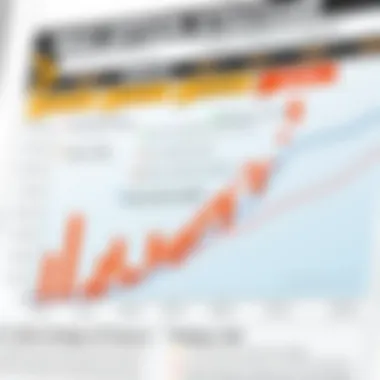Max Option Trading: Strategies for Smart Investors


Intro
Navigating the world of options trading can feel like stepping into a high-stakes poker game. For anyone who’s ever been drawn to the thrill of market fluctuations, max option trading presents unique opportunities that promise not only potential gains but also considerable risks. Understanding these facets is essential for those keen on optimizing their investments.
This article dives into the strategies that savvy investors employ to excel in max option trading, ensuring they are equipped with the tools and insights necessary to make informed choices. The aim is to demystify the complexities surrounding options trading and present approachable tactics that cater to various experience levels—from curious newcomers to seasoned veterans.
As we dissect elements such as psychological triggers, market conditions, and strategic insights, we aim to arm investors with the knowledge they need to seize opportunities and mitigate risks in a dynamic environment.
Investment Dictionaries
Key Financial Terms
Before delving further, it’s critical to familiarize yourself with some key financial jargon surrounding max option trading. Knowing these terms can influence your decision-making process.
- Options: Agreements granting an investor the right, but not the obligation, to buy or sell an asset at a predetermined price before a specified date.
- Strike Price: The fixed price at which an option can be exercised.
- Expiration Date: The last day an option is valid, after which it becomes worthless if not exercised.
- Premium: The price an investor pays to purchase an options contract.
- Volatility: A statistical measure of the dispersion of returns for a given security or market index, often influencing option pricing.
Familiarizing yourself with these terms equips you with the foundation needed to understand strategies in options trading more thoroughly.
Investment Strategies Explained
Understanding the various investment strategies applied in max option trading illuminates ways to potentially maximize returns. Here are some strategies worth noting:
- Covered Call: This strategy involves holding a long position in an underlying asset while selling call options on that same asset. It generates income but caps potential upside.
- Protective Put: Investors buying this option protect themselves against downward market movements. It involves purchasing a put option while holding shares of an asset.
- Straddle: Involves buying both a call and put option for the same strike price and expiration date. It’s suitable in situations expecting significant volatility.
- Iron Condor: A more advanced strategy that consists of selling out-of-the-money puts and calls while simultaneously buying further out-of-the-money options. It can yield moderate profits with limited risk.
- Calendar Spread: This tactic can yield benefits by exploiting time decay. It involves buying and selling options at the same strike price but with different expiration dates.
These strategies reflect the diverse approaches traders can take to navigate the potential and pitfalls of the options market, allowing each individual to tailor their tactics to their risk tolerance and investment goals.
"To maximize profits, one must not only understand the mechanics of trading but also read the subtleties of the market as one might read a book, paying attention to the plot’s nuances."
The parameters you set during trading ventures can define success. Continuous learning about market behavior, combined with effective strategies, creates a pathway toward enhanced investment outcomes. Understanding risk management and keeping emotions at bay are fundamental elements in this demanding arena.
Understanding Max Option Trading Basics
Understanding Max Option Trading is crucial for anyone looking to navigate the complex waters of options trading. This foundational knowledge equips investors with the insights necessary to craft strategies that can effectively maximize returns while managing risks.
In this article, we will delve into essential aspects such as defining what Max Option Trading truly means, as well as becoming familiar with key terminology that will serve as the building blocks in your trading journey. Grasping these concepts not only sharpens your ability to make informed decisions, but it also positions you to develop strategies that fit your investment style and market conditions.
Defining Max Option Trading
Max Option Trading refers specifically to the practice of maximizing the potential financial gain from options contracts. This approach involves not just basic trading but also optimizing various parameters to enhance profitability. It's not just about playing the market; it’s about understanding it deeply. The essence lies in leveraging both the complexity of options themselves and the market dynamics at play.
Having a solid grasp of Max Option Trading allows investors to strategize effectively. Investors can scrutinize different scenarios and adjust their positions accordingly. This flexibility is the name of the game with options—if you know what you’re doing, you can open up a realm of profitable possibilities.
Key Terminology in Options Trading
To confidently dive into Max Option Trading, familiarizing oneself with specific terms is necessary. Here are some key components:
Options Contracts
Options contracts represent an agreement between a buyer and a seller, granting the buyer the right, but not the obligation, to buy or sell an underlying asset at a predetermined price before a specific date. This flexibility allows traders to capitalize on market fluctuations without the immediate commitment involved in buying or selling the stock directly. A major advantage of options contracts is that they can provide substantial leverage, enabling traders to control large amounts of stock with a relatively small capital outlay.
However, while they offer great potential for profit, options contracts also come with inherent risks, primarily the possibility of losing your entire investment if the market doesn't go as anticipated.
Strike Price
The strike price is the predetermined price at which the holder of an options contract can buy or sell the underlying asset. It’s key to determining the potential profitability of the option. This price has a critical influence on whether the option is considered to be 'in the money' or 'out of the money.'
One important aspect of the strike price is how it dictates the risk-reward balance in trading strategies. Opting for a lower strike price may yield higher potential gains but often involves increased risk, and vice versa. Thus, carefully selecting the strike price is instrumental in optimizing the potential returns on options trades.
Expiration Date
The expiration date marks the deadline for exercising an options contract. This time constraint is both a boon and a bane. It creates urgency in trading, which can lead investors to make hasty decisions. One key characteristic of the expiration date is the time decay of options value—the closer to expiration, the faster the option may lose value if it remains out of the money.
Understanding the expiration date is vital for traders who wish to employ time-sensitive strategies. This knowledge can significantly impact the overall outcome of a trading strategy, as timing is as important as the execution itself. Choosing the right expiration date can help to manage risk effectively while maximizing the potential for gains.
Knowing the ropes of Max Options Trading starts with mastering these terms, which are the bedrock of your trading strategies. Without them, you may find yourself lost at sea when the market tides change.
The Mechanics of Max Options Trading


Understanding the mechanics of max options trading gives investors a grasp on how options function and interact with various market dynamics. This knowledge is essential as it equips traders with the tools to navigate the complexities of the market effectively. Knowing how options work is not just a matter of intellectual curiosity; it can significantly impact trading outcomes and overall investment strategy. Delving into this subject enables traders to make informed decisions that could potentially lead to greater profitability or minimized losses.
How Options Work
Options trading represents a fascinating aspect of the financial market that draws many investors. At its core, options provide investors with flexibility, allowing them to speculate on stock movements without outright purchasing shares. However, the foundation lies in understanding calls and puts.
Calls and Puts
Calls and puts are the two primary types of options. A call option gives the buyer the right to purchase the underlying asset at a predetermined price within a specific time frame. On the other hand, a put option offers the right to sell. This dichotomy is vital, as it offers investors varied strategies based on market predictions.
One key characteristic of call options is their bullish nature; they are a popular choice when investors anticipate the asset price will rise. Conversely, put options tend to garner interest in bearish sentiments. One unique feature is the asymmetric risk; unlike stocks, where losses can be significant, options often limit risk to the premium paid, minimizing the fallout during a downturn.
Premiums and Valuation
Premiums in options trading refer to the price an investor pays to purchase an option. This amount plays a significant role in valuation, as it reflects the risk and potential reward associated with the option. The premium is influenced by factors like time until expiration, volatility, and the relationship between the strike price and the underlying asset’s market price.
The vital characteristic of premiums is that they can fluctuate significantly due to market conditions. This variability means that savvy investors must understand valuation principles to determine whether an option is fairly priced or potentially overvalued. A unique aspect here is the time value of options; as expiration nears, the time value diminishes, which can lead to greater risks if one holds onto an option too long. Hence, balancing the timing with pricing becomes crucial for effective trading.
Understanding Leverage and Margins
Leverage is akin to a double-edged sword in trading. It allows traders to take larger positions in the market without needing to invest the full capital required for those positions. This characteristic is a vital aspect of max options trading as it can significantly amplify returns.
Leverage Dynamics
The concept of leverage dynamics in trading reflects the potential to control larger amounts of the underlying asset with a smaller capital outlay. This is particularly appealing because it can achieve higher returns with less initial investment. However, it’s a slippery slope; while potential gains may be substantial, losses can also multiply swiftly. One must tread carefully, as this dynamic could lead to financial pitfalls if mismanaged.
Margin Requirements
Margin requirements are rules set by brokerages that dictate the amount of money an investor must maintain in their account when trading on margin. They are essential for protecting both the investor and the brokerage from excessive losses. The specific characteristic of margin requirements ensures a buffer is present, which helps manage the inherent risks of trading.
A significant advantage of knowing these requirements is that it allows traders to plan their positions intelligently. However, there’s a downside. If market movements occur against an investor’s position, the required margin can increase, potentially forcing the investor to liquidate positions at an inopportune time, which can lead to locking in losses.
In summary, the mechanics surrounding max options trading are intricate but vital for achieving success in the options market. Mastering how options work—from calls and puts to premiums and leverage—forms the backbone of navigating this complex but rewarding territory.
Strategic Approaches in Max Option Trading
Understanding the strategic approaches in max option trading is paramount for any investor looking to make informed decisions in the complex landscape of options. These strategies serve as a framework that guides traders in navigating the volatility of the markets and making choices that align with their financial goals. By developing a robust strategy, traders stand to manage risks effectively, capitalize on market movements, and ultimately enhance their profitability.
Identifying Suitable Trading Strategies
Covered Calls
Covered calls are a common strategy employed by many investors. This strategy involves holding a long position on the underlying asset while simultaneously selling call options against that position. The primary characteristic of a covered call is that it can generate additional income from premiums collected on the options sold. One of the competitive advantages of using covered calls lies in its income-generating potential. It provides a cushion against potential declines in the stock's price, thus making it a popular choice among conservative investors.
However, the unique feature of covered calls also presents a disadvantage: the upside potential of the underlying stock is capped. If the stock price increases significantly beyond the strike price, the investor may miss out on potential gains. This balance between income and upside potential is something every savvy trader must consider when employing this strategy.
Protective Puts
Next on the list is the protective put strategy, which allows investors to hedge against unfavorable movements in the underlying asset. In essence, it involves buying put options while holding the underlying stock. The key characteristic of protective puts is their ability to limit losses while still allowing for unlimited upside potential.
This makes protective puts a favorable choice for risk-averse investors who wish to continue participating in market gains while safeguarding their investments. A standout aspect is that if the underlying asset loses value, the profit from the put option can offset the losses incurred from the stock, providing a safety net. That being said, the cost of purchasing put options adds an extra layer of expenditure, which could become a disadvantage if the expected move doesn’t materialize.
Straddles and Strangles
Finally, we have the straddles and strangles strategy, primarily suited for investors who anticipate volatility in the underlying asset but are unsure of the direction. Straddles involve buying both a call and a put option for the same strike price and expiration date, while strangles require buying both options but at different strike prices.
What makes these strategies particularly appealing is their potential for profit regardless of market direction. If the price swings significantly either way, one option can offset the loss of the other, creating a favorable outcome. However, the downside is the need for significant price movement to make these strategies profitable, as both options come at a premium.
Utilizing Technical Analysis
Technical analysis plays a crucial role in max options trading. With this, traders evaluate market trends and make educated predictions about future price movements by analyzing historical data.
Chart Patterns
Chart patterns are pivotal in the realm of technical analysis, serving as visual indicators of potential market movement. These patterns can signal bullish or bearish trends and help traders make more informed decisions based on historical price movements. Key characteristics include the identification of formations such as head and shoulders, triangles, and flags, which suggest possible continuation or reversal of trends. Chart patterns provide a visual representation of market psychology, making them advantageous for traders. However, it’s important to note that patterns can be subjective, presenting a unique challenge in their interpretation.
Indicators and Indicators
When it comes to identifying potential trading opportunities, various indicators come into play. Indicators include moving averages, relative strength index (RSI), and Bollinger Bands, each with its own strengths. The utility of these technical tools lies in their capacity to provide traders with crucial data on market conditions. For instance, the RSI can signal potential overbought or oversold conditions, guiding traders on when to enter or exit positions. However, over-reliance on indicators without considering broader market context may lead to misguided trades.


Traders who blend different approaches, combining both fundamental and technical analysis, often find themselves better positioned to make sound decisions in max option trading. By keeping an eye on the big picture and remaining adaptable to changing market conditions, investors can utilize these strategies to enhance their trading toolkit.
Risk Management in Max Options Trading
When it comes to the world of max options trading, having a solid risk management strategy isn’t just a luxury; it’s an absolute necessity. The volatility of the market can lead to significant swings in option prices, meaning that investors can quickly find themselves in precarious situations if they are not vigilant. Risk management helps safeguard your investments, giving you a systematic approach to handle potential losses while maximizing profits. With options trading, the stakes can be high, and one wrong move could unravel a carefully constructed portfolio, making risk management all the more critical.
Assessing Risks Involved
Market Volatility
Market volatility is one of those terms tossed around like confetti at a party, but it holds genuine significance for traders. In the context of options, volatility represents the degree of variation in the price of the underlying asset over time. The higher the volatility, the more unpredictable the price swings, which can present both opportunities and threats. The key characteristic of market volatility is its capacity to affect option premiums; increased volatility typically inflates premiums, creating potentially enticing opportunities for options traders.
The beneficial aspect of trading in volatile markets lies in the potential for large gains. If a trader accurately predicts a significant move, they stand to make a killing. However, the flip side is that increase volatility can lead to steep losses if things don’t go the trader’s way, making it crucial to monitor this metric closely.
"Volatility doesn’t drive strategy; it shapes it. Knowing when to engage and when to pull back is the hallmark of a savvy trader."
Option Assignment Risk
Option assignment risk is another layer of complexity in the realm of max options trading. This risk arises when an option holder exercises their right, and the seller must fulfill their obligation to buy or sell the underlying asset. A key characteristic of this risk is its unpredictability; one moment you may be trading a predictable boundary, and the next, you’re suddenly on the hook to make a transaction.
The unique feature of assignment risk lies in its timing. Traders might not know when an assignment will occur, which can disrupt trading plans and lead to unexpected losses. Managing this risk is essential, particularly for those engaging in strategies involving writing options. There’s a potential upside in gaining premium income, but the wrong move can turn profitable positions into liabilities in the blink of an eye.
Establishing a Risk Management Plan
Diversification Strategies
When it comes to risk management in options trading, diversification strategies play an indispensable role in mitigating risks. By spreading investments across various assets or instruments, traders can reduce their reliance on a single position or market behavior. This is pivotal, considering how erratic the markets can be; one bad apple shouldn’t spoil the whole bunch. Diversifying your portfolio becomes not just a method of increasing potential returns but also a protective mechanism against downside risk.
The key characteristic of diversification is that it helps even out performance. When one stock takes a nosedive, another might soar, balancing your overall portfolio performance. However, too much diversification can lead to diluted returns; it’s all about finding that sweet spot.
Setting Stop-Loss Orders
Setting stop-loss orders is another indispensable technique in a trader’s risk management toolkit. A stop-loss order acts as a safety net, allowing traders to limit their potential losses by selling an asset once it reaches a pre-defined price. This characteristic can help traders maintain discipline in their trading and avoid emotional decisions that often lead to losses.
The unique aspect of stop-loss orders is their ability to execute trades automatically, taking the guesswork out during tumultuous market fluctuations. While they provide a significant layer of protection, they also come with disadvantages, such as the potential for premature selling during temporary price dips. Still, having this in place can offer traders peace of mind, especially in a volatile trading environment.
Market Conditions Affecting Max Option Trading
Market conditions play a critical role in the dynamics of max option trading. They influence not just the pricing of options but also the strategy and timing behind trades. With the ever-shifting landscape of the financial markets, understanding these conditions can be the difference between a profitable trade and a costly misstep.
Investors who can identify and adapt to current market conditions are better positioned to capitalize on opportunities. It's essential to keep an eye on various indicators that can provide vital insights into market trends. This section will explore economic indicators such as interest rates and employment reports, then delve into how cycles like bull and bear markets can shape trading decisions.
Economic Indicators and Their Impact
Interest Rates
Interest rates are often a litmus test for the overall market. These rates dictate the cost of borrowing money and can significantly affect both consumer spending and corporate investments. When rates are low, consumers have more disposable income, and businesses often invest more aggressively in growth, creating a favorable environment for traders. On the flip side, high interest rates can result in tighter monetary conditions, leading to reduced spending and a slackening of market activity.
- Key Characteristic: Interest rates act as a signal for economic health. They can provide hints of future market trends, making them an essential indicator for traders.
- Advantages: When successfully anticipated, changes in interest rates can allow traders to adjust their strategies, enabling them to hedge against potential risks or seize opportunities inherent in shifting market dynamics.
- Unique Feature: The influence of rate changes can ripple through various sectors; for instance, technology shares might bloom in a low-rate environment, while financial stocks may thrive when rates are increased.
Employment Reports
Employment reports act as a pulse check on the economy's strength. When jobs are plentiful, consumer confidence typically swells, leading to higher consumption levels and, subsequently, a more robust market. Conversely, poor employment figures can dampen sentiment and indicate potential downturns in the market.
- Key Characteristic: These reports provide a snapshot of economic performance and often correlate with market movements. Investors closely watch these figures as they forecast future economic activity.
- Advantages: A strong employment report can bolster market confidence, prompting traders to enter into options positions that benefit from upward movements in stock prices.
- Unique Feature: Employment rates have a tendency to lag behind other indicators, so while they are essential, they might not always reflect immediate market sentiment.
Navigating Market Cycles
Market cycles can dramatically influence how options are traded and valued. Traders need to be astute when navigating these cycles, which generally consist of phases labeled as bull and bear markets.
Bull and Bear Markets
Understanding bull and bear markets is crucial for any savvy investor. Bull markets, characterized by rising prices, typically inspire confidence and lead to increased trading activity. On the contrary, bear markets, where prices decline, often instill caution, prompting traders to rethink risk and diversify.
- Key Characteristic: These market phases define performance timeframes for various assets, with bull markets usually increasing volatility and bear markets often heightening risk awareness.
- Advantages: Recognizing the signs of each market condition can guide traders into or out of positions effectively. Adapting strategies accordingly allows for potential profit maximization or loss mitigation based on the prevailing cycle.
- Unique Feature: Market sentiment can shift rapidly; hence, being in tune with current trends can enhance one's decision-making capabilities.
Market Sentiment Analysis
Market sentiment analysis delves into the psychological factors influencing investment decisions. It encompasses how feelings about economic conditions can propel market movements, regardless of factual indicators.


- Key Characteristic: Sentiment can sway market directions significantly and can also lead to overreactions—either excessively bullish or overly pessimistic behaviors.
- Advantages: By grasping the underlying sentiment, traders can align their strategies with the prevailing mood—allowing for contrary trades that capitalize on market corrections.
- Unique Feature: Market sentiment reflects collective human behavior; tools like social media trends or news headlines complement traditional analyses and provide a broader view.
"Understanding market conditions is like reading the weather before going out; it prepares you for what lies ahead."
In summary, both economic indicators and market cycles provide traders with reliable frameworks to evaluate their strategies. By paying attention to interest rates, employment reports, and the broader market sentiments, investors can craft more strategic and informed trades.
Psychological Factors in Options Trading
Understanding the psychological aspects of options trading is pivotal for any investor who desires to navigate the complexities of max option trading effectively. Traders don't operate in a vacuum; their decisions are deeply influenced by emotions and mindset. Recognizing these psychological factors can lead to better decision-making, ultimately enhancing trading performance.
Emotional Influences on Decisions
Overconfidence Bias
Overconfidence bias is a common phenomenon among traders that often leads them to overestimate their knowledge or ability to predict market movements. This particular trait can easily cause seasoned and novice investors alike to make impulsive choices, thinking they’ve got the winning formula just because they’ve had a string of good trades. The key characteristic of overconfidence bias is the tendency to act on assumptions rather than on sound research or analysis.
This article points out that such tendencies might find their roots in past successes that create an illusion of control. However, while a sprinkle of confidence can be beneficial, overconfidence can cloud judgment, leading to significant risks being ignored.
"When it comes to options trading, a trader's overestimation of their abilities can turn a lukewarm opportunity into a high-stakes gamble."
Fear and Greed
Fear and greed are perhaps the two powerful emotions that drive human behavior in trading. Fear often prompts a trader to exit positions too early, worried about potential losses. Conversely, greed might push them to hold on for too long, chasing that elusive higher profit. The key characteristic of fear and greed is their volatility; they can swing a trader’s decisions in a heartbeat. In this article, recognizing the balance between the two can enhance trading habits, promoting a more rational approach.
Navigating fear successfully often means having a solid risk management plan, while controlling greed helps traders stick to their strategies without getting distracted by fleeting market movements.
Developing a Trader's Mindset
Having the right mindset is crucial for success in options trading. This means cultivating discipline and patience, and committing to continuous learning. Each of these elements plays an important role in achieving better trading outcomes.
Discipline and Patience
Discipline and patience go hand in hand in trading. A disciplined trader is one who adheres to their trading plan – diligently following through with entry and exit points regardless of market fluctuations or emotional reactions. The key characteristic here is consistency; disciplined traders are more likely to be successful over time.
Patience is equally important. It allows traders to wait for optimal trading opportunities rather than hopping on every small movement. This article argues that developing discipline and patience leads to a more systematic approach to trading, reducing impulsive actions that stem from emotional responses.
Continuous Learning
Continuous learning is vital in staying ahead in options trading. The markets are always changing – new strategies, patterns, and economic factors come into play all the time. Investors who prioritize ongoing education enhance their understanding and adapt to market dynamics more efficiently. The unique feature of continuous learning is that it promotes an analytical mindset, encouraging traders to critically evaluate past trades while integrating new information.
This article emphasizes the importance of learning, noting that it provides traders with a powerful toolkit to refine their strategies while mitigating risks. Keeping abreast of market trends, reading relevant literature, or even participating in webinars can open doors to deeper insights.
Practical Insights for Aspiring Traders
Gaining a foothold in the world of option trading can be as tricky as navigating a foggy day without a compass. This section brings to light practical insights for aspiring traders, demystifying the path forward. Understanding the landscape of option trading, beyond just theoretical knowledge, is vital for anyone looking to tread into these waters confidently.
A broad array of resources is available, from books to online platforms that provide extensive training. The goal here is not just to highlight these resources but to explain their roles and why they matter in the bigger picture of trading development. Developing a strong knowledge base enables traders to make informed choices, foresee challenges, and devise strategies that lead to profitable outcomes.
Resources for Further Learning
Books and Articles
Books and articles serve as the backbone of any trader’s education. They provide a solid foundation, encompassing both fundamental principles and advanced strategies. Titles such as "Options as a Strategic Investment" by Lawrence G. McMillan are frequently recommended due to their depth and clarity. This particular book breaks down complex concepts into digestible chapters, making it a popular choice among both novice and experienced traders.
The unique characteristic of books is their ability to offer context; they paint a picture that articles often cannot. Articles are typically brief and focus on a singular aspect, while books allow for a comprehensive exploration of the subject. For instance, a book may delve into the psychology of trading, offering insights into emotional management—a critical component often neglected by traders.
Online Courses and Webinars
Online courses and webinars represent a more dynamic approach to learning. These platforms often offer interactive elements such as live Q&A sessions and discussions, which can provide a more engaging learning experience. Websites like Investopedia and Coursera frequently provide shortcuts to understanding complicated concepts through visual aids, simulations, and real-time examples.
What sets online courses apart is the immediacy of the feedback loop. Learners can ask questions in real-time and receive instant clarifications, which can deepen their understanding. However, it’s important to be mindful of the potential pitfalls, such as information overload and courses that lack depth. Picking reputable sources is essential to avoid misinformation and ensure a solid grounding in the subject.
Common Pitfalls to Avoid
Neglecting Due Diligence
One of the gravest mistakes a trader can commit is neglecting due diligence. It’s like setting sail without checking the weather—you’re bound to encounter rough seas. This entails researching not just the underlying asset but also market conditions, the economic environment, and any relevant news that could sway price movements.
Due diligence is crucial because even the most foolproof strategies can fall apart without the backing of thorough research. Traders who skip this step often make impulsive trades based on hearsay or rumors, leading to significant losses. Cultivating a habit of mindfulness regarding information—scrutinizing sources and ensuring reliability—will pay off in the long run.
Chasing Losses
Chasing losses can lead to a downward spiral akin to a hamster stuck in its wheel. When traders try to recover their losses by making riskier bets, they often end up compounding their problems. This behavior is frequently exacerbated by emotional stress and the desire to prove oneself, resulting in decisions that stray from a sound strategy.
The potency of discipline cannot be overstated here. Recognizing when to step back after a series of losses is crucial for long-term success. Building a robust trading plan that includes exit strategies and loss limits can help mitigate the urge to chase losses. The emotional toll of trading is often underestimated, and aspiring traders must be vigilant against their own psyche.







